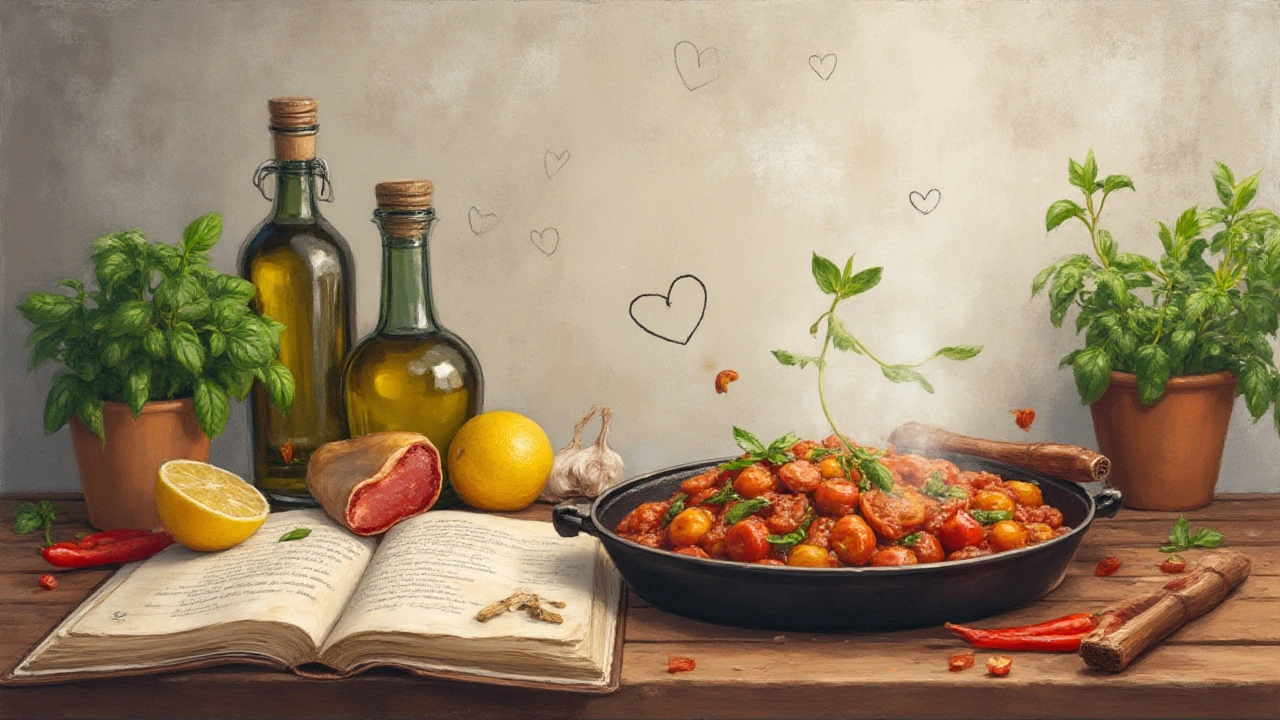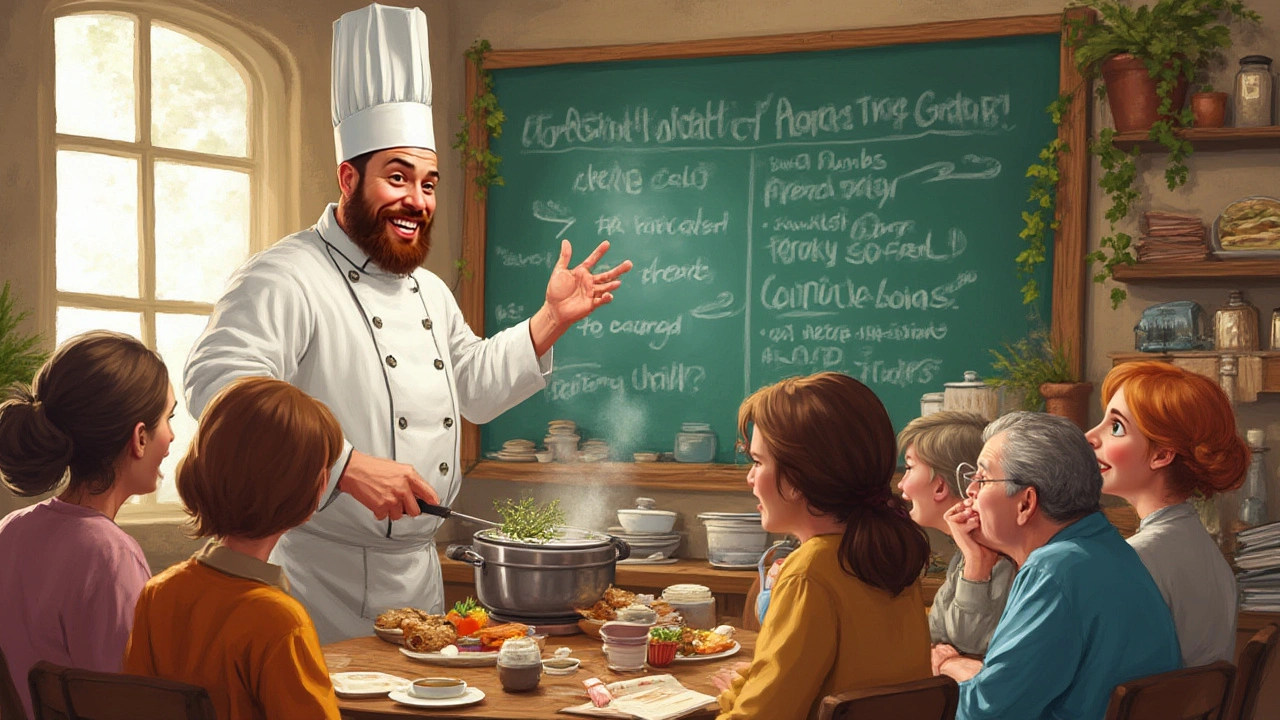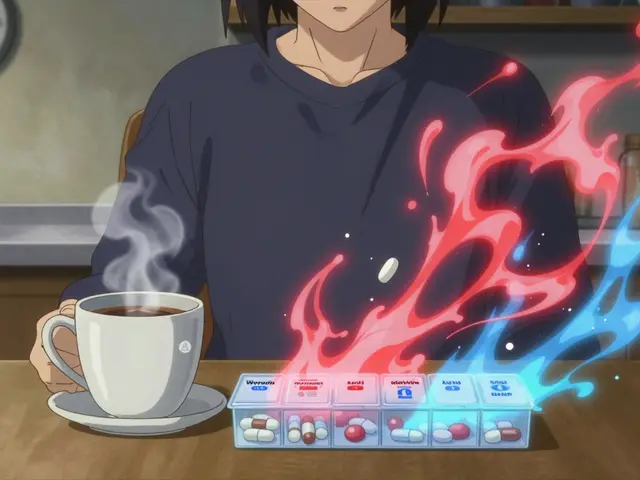Most people think salt just adds taste to food, but here’s the twist: too much of it can sneakily cause your pants to fit tighter by nightfall. Ever polish off a big bag of chips or a pre-made soup and notice that heavy, puffy feeling a few hours later? That’s your body holding onto extra water just to balance out all that sodium. If you’re tired of ballooning up after lunch or dinner, you’re in the right place. Let’s break the cycle of salty meals that sabotage your comfort, all while keeping flavor front and center.
Why High Salt Equals Extra Puffiness
Let’s not sugarcoat it—salt plays a real trick on your body. When you eat more sodium than your body needs, your system goes into defense mode and starts holding onto more fluid. This is literally why you find yourself with rings that won’t budge or a stomach that feels too tight in the evening, even if you didn’t go wild at the table. The science is simple: sodium makes your kidneys hang onto water, which leads to swelling (the technical term is edema) and that dreaded bloat.
If you want a real-world example, take the National Health and Nutrition Examination Survey—they tracked more than 10,000 adults and found that people who regularly go above 2,300 mg of sodium a day (just about a teaspoon of salt) have not only higher rates of fluid retention, but also raised risks for high blood pressure and heart problems. That’s a double whammy most of us would like to dodge. And don’t kid yourself: you can’t just sweat it out at the gym or drink it away. If salt keeps going in, the bloat will keep coming back.
So, why not try out some swaps and strategies to get the taste without the trouble? By playing with herbs, spices, and clever kitchen techniques, you can keep food exciting and your stomach flat(ter). This isn’t about bland steamed broccoli or naked chicken breasts. We’re talking flavor bombs—like smoked paprika, zesty citrus, and punchy garlic that make salt nearly pointless.
The Secret Seasonings That Outshine Salt
Craving that oomph in your next dinner? You don’t need a salt shaker to make it happen. Chefs have been playing this game for decades, and the pros all agree—acids, aromatics, and spices are the real way to bring food to life. Lemon juice, vinegar, and lime aren’t just salad dressing starters—they sharpen up a whole dish and trick your tastebuds into thinking there’s more going on than there really is.
Here’s the best part: you can use single spices or make custom blends. Smoked paprika brings depth you’d expect from BBQ without a grain of salt. Garlic powder (not garlic salt!) boosts umami in everything from popcorn to mashed potatoes. Fresh herbs like parsley, cilantro, basil, or dill add a burst of green and a flavor kick that makes salt feel like yesterday’s news. Try chili flakes for heat, a hit of cumin for earthiness, or even ground ginger for warmth.
Start experimenting with what’s in your pantry. Mix black pepper, oregano, and lemon zest for a Greek vibe. Toss rosemary and thyme with roasted veggies for a rustic twist. Or, make a southwestern blend of ancho chili powder, coriander, garlic powder, and just a whisper of cinnamon. Keep these tricks in your back pocket when you’re eyeing that salt container, and you’ll notice you miss the sodium way less.

Flavor-Packed, Lower-Salt Meal Ideas
Ready to put these tips into action? You don’t need a culinary degree to make a week’s worth of tasty meals that won’t leave you bloated by bedtime. Here are a few crowd-tested dishes where salt is just a background actor, not the star:
- Za’atar-Rubbed Chicken Thighs: Coat skinless thighs in za’atar, lemon juice, and olive oil. Roast in the oven and serve on a bed of cucumber-yogurt salad with mint and dill.
- Spicy Garlic-Lime Shrimp Tacos: Sauté shrimp in garlic, a bit of chili powder, and splash in lime juice at the end. Fill corn tortillas with the shrimp, shredded cabbage, and a creamy avocado salsa.
- Herby Farro Salad: Cook farro with a bay leaf for depth. Toss with grape tomatoes, chopped parsley, a good glug of olive oil, and a sprinkle of feta—not too much. Add crushed red pepper flakes for bite.
- Roasted Veggie Sheet Pan Supper: Chop up whatever’s on hand—casually toss broccoli, bell peppers, carrots, and sweet potatoes with smoked paprika, thyme, and a drizzle of balsamic before roasting.
- Miso-Ginger Salmon: Whisk white miso with grated ginger, garlic, a dash of maple syrup, and brush on salmon fillets. Bake until juicy and serve with steamed bok choy and brown rice.
Breakfast and lunch can work too: Greek yogurt with strawberries, chia seeds, and honey. A grain bowl with quinoa, roasted Brussels sprouts, shredded chicken, and a dollop of lemon-tahini sauce. Even just switching from salty almond butter to plain, unsalted versions on your morning toast makes a difference in daily sodium.
Smart Shopping: Reading Labels Like a Pro
It’s easy for sodium to creep up when you shop hungry or love convenience foods. Processed stuff, canned goods, premade sauces, and ready meals can hide a whole day’s worth of salt in a single serving. The average American gets nearly 70% of their sodium not from the salt shaker, but from packaged foods. Ouch.
Here’s a quick cheat sheet for smarter shopping:
- Check for "low sodium" or "no salt added" on labels, especially with canned veggies, beans, and broths.
- Look for <200mg of sodium per serving in snacks and breads. Even your sandwich bread can be a hidden culprit!
- Skip seasoning mixes with “salt” or “sodium” near the top of the ingredient list. Go for pure dried herbs and spices instead.
- Watch portion sizes. Even low-sodium foods can add up if you eat double what the label says.
If you want a crash course in how sodium messes with your body’s fluid balance, check out this article on how to reduce salt bloating for a deeper dive and practical strategies.

Lower Salt, Higher Health: What Science Says
The evidence stacks up: less sodium equals less swelling and, in a lot of folks, lower blood pressure too. Swapping out just 1,000 mg of sodium per day can trim several pounds of water weight in a week—not magic, just fluid your body doesn’t need to lug around. People who cut down on salt typically see improvements in blood pressure, less facial puffiness, and bloat reduction in days, not weeks.
Here’s a handy table with what to aim for and what to skip:
| Food | Average Sodium (mg/serving) | Low-Sodium Swap (mg/serving) |
|---|---|---|
| Regular canned soup | 900 | Homemade veggie soup with herbs (150) |
| Store-bought rotisserie chicken | 450 | Home-roasted chicken thigh (60) |
| Bread (2 slices) | 250 | Sourdough or no-salt bread (40-60) |
| Peanut butter (2 tbsp) | 150 | Unsalted (5) |
| Salted mixed nuts (1 oz) | 120 | Unsalted nuts (0) |
| Pasta sauce (1/2 cup) | 400 | Homemade tomato sauce with basil & garlic (50) |
Make your kitchen work for you. Pre-prep herb mixes or spice blends, keep lemons and limes handy, and learn to appreciate umami from mushrooms, tomatoes, miso, or nutritional yeast (yep, that’s a thing, and it’s great sprinkled on popcorn or eggs). You might just start craving flavor instead of just salt.
So, next time you’re tempted to grab the shaker or reach for the premade stuff, remember: the smartest seasoning isn’t salt. It’s a little creativity, a lot of flavor combos, and a commitment to staying bloat-free. Your body—and especially your belly by dinnertime—will thank you.









I used to think salt was harmless until I started noticing my rings wouldn't come off by 7pm. Switching to smoked paprika and lemon zest changed everything-no more puffiness, and my food actually tastes better now. I didn't even miss the salt.
Also, za’atar on chicken? Game changer. Just made it last night and my partner asked if I hired a chef.
Oh sweet mercy, another ‘low-salt’ wellness blog. I’m sorry, but if your food needs a ‘flavor bomb’ to be edible, you’re not cooking-you’re compensating. Real food doesn’t need 17 herbs and a citrus peel to be good. Salt is nature’s seasoning. The rest is just culinary performance art.
Also, ‘no salt added’ broth? That’s just warm water with a sad vegetable ghost in it.
Look, I get it-salt causes water retention, and yeah, I’ve felt that bloated after a burrito night. But here’s the thing: it’s not just about swapping salt for spices. It’s about understanding how your body processes sodium over time. Some people are salt-sensitive, some aren’t. And honestly, if you’re eating a lot of processed stuff, even ‘low-sodium’ labels are misleading because they still pack in hidden sodium from preservatives like sodium nitrate or monosodium glutamate.
What really helped me was tracking my intake for two weeks with a food diary app. Turns out, my ‘healthy’ granola bar had 300mg of sodium. That’s like a quarter of my daily limit right there. Once I started cooking from scratch-real onions, real garlic, real herbs-I stopped feeling like a water balloon after dinner. Also, vinegar is magic. A splash of apple cider vinegar on roasted veggies? Like a flavor upgrade you didn’t know you needed.
Smoked paprika is underrated. I put it on eggs. On popcorn. On avocado toast. You don’t need salt when you’ve got smoke and heat. Also, garlic powder-not garlic salt-is the real MVP. One of those little containers lasts forever and never turns your food into a sodium bomb.
The physiological mechanism of sodium-induced edema is well-documented in renal physiology: hypernatremia triggers osmotic shifts that increase extracellular fluid volume via aldosterone-mediated sodium reabsorption in the distal nephron. The clinical correlation between sodium intake and hypertension is supported by multiple meta-analyses, including the Cochrane review from 2021.
However, the notion that flavor can be entirely decoupled from sodium is misleading. Umami, acidity, and aromatic compounds enhance palatability by stimulating different sensory pathways-TRP channels, T1R receptors, and olfactory bulb activation-but they do not fully replicate the hedonic impact of sodium. The solution isn’t substitution-it’s habituation. Gradual sodium reduction over 6–8 weeks allows taste bud sensitivity to recalibrate, making lower-sodium foods more satisfying. This is supported by longitudinal studies from the American Heart Association. Don’t replace salt. Retrain your palate.
Wow. Just wow. Another ‘eat herbs and cry’ diet guru telling you salt is the devil. Do you even know what salt does in your body besides make you bloated? It’s essential for nerve conduction, muscle contraction, and maintaining blood pressure. You can’t just ‘swap’ it out like a bad Tinder date. People who think ‘za’atar’ fixes everything are just trying to feel superior while eating sad, flavorless food.
And ‘no salt added’ broth? That’s just boiled disappointment. I’d rather have a can of chicken noodle soup with 800mg sodium than your ‘herby farro salad’ that tastes like grass clippings with a side of regret. Also, who eats miso salmon and calls it ‘healthy’? That’s fermented soy paste with sugar and salt-don’t pretend you’re not still eating junk.
Okay but have you tried putting a pinch of sumac on everything? Like literally everything? I put it on my oatmeal. I put it on my yogurt. I put it on my water. I’m not even joking. It’s like lemon’s spicy cousin who shows up to the party and steals the spotlight. Also, I used to think I needed salt on my eggs until I tried smoked paprika and now I feel like a traitor to my own taste buds. Also also-don’t even get me started on pre-made sauces. They’re basically liquid sodium bombs with a side of regret. I’m done.
Oh my GOD. I just made the miso-ginger salmon and I cried. Not because it was sad. Because it was the first time in 12 years that I ate something that didn’t make me feel like a swollen marshmallow by 9pm. I thought I was doomed to bloat forever. Turns out, I just needed to stop treating my body like a landfill and start treating it like a temple. I’m not even kidding. I’ve never felt so… light. Like my insides finally got a spa day. I’m sending this to my mom. She’s gonna hate me for it but she needs to see this.
Empirical data indicates that dietary sodium intake above 2.3 g/day correlates with elevated extracellular fluid volume in 60–70% of the hypertensive population. However, the efficacy of flavor substitution via phytochemicals is not statistically significant in blind taste trials. The perception of flavor enhancement is largely confounded by placebo effect and cognitive bias. Furthermore, commercial spice blends often contain undisclosed sodium additives-check the ingredient list for ‘natural flavors’ or ‘autolyzed yeast extract.’
THIS. IS. A. REVOLUTION. 🙌 I used to think salt was my best friend. Now I know it was my toxic ex. I made the za’atar chicken last night and I didn’t even touch the salt shaker. I felt like a new person. Like I could breathe again. Like my jeans remembered how to zip. I’m not crying. You’re crying. 🥹
Oh my GOSH, I just tried the roasted veggies with smoked paprika and balsamic and I think I just had a spiritual awakening??? 🙏✨ I used to eat canned soup every night because I was too tired to cook… now I’m chopping veggies like a person who has their life together!!! And I didn’t even miss the salt!!! I’m sending this to my entire family!!! 💕❤️🔥
Are you aware that the pharmaceutical industry and the salt lobby have colluded to suppress research on potassium-sparing diuretics? Sodium retention is not natural-it is engineered. The WHO’s guidelines are funded by multinational food corporations. Your ‘herbs and spices’ solution is a distraction. The real issue is corporate manipulation of your biochemistry through hidden sodium additives in ‘healthy’ foods. Read the label. If it has more than five ingredients, it’s probably designed to keep you bloated and dependent. The truth is hidden. Wake up.
People who think swapping salt for paprika is a solution are delusional. You’re not fixing the problem-you’re just hiding it under a pile of expensive spices. Real health isn’t about flavor bombs. It’s about discipline. Stop eating processed food. Stop buying ‘low sodium’ lies. Cook from scratch. Eat meat. Eat vegetables. Don’t add anything. That’s it. No gimmicks. No ‘za’atar.’ No ‘miso.’ Just food. And if you’re bloated, maybe it’s not the salt-it’s your entire lifestyle.
Just stop using salt. Done. That’s it. No other advice needed. If you need more flavor, you’re doing it wrong. Eat real food. Stop overcomplicating it. Your body doesn’t need your drama.